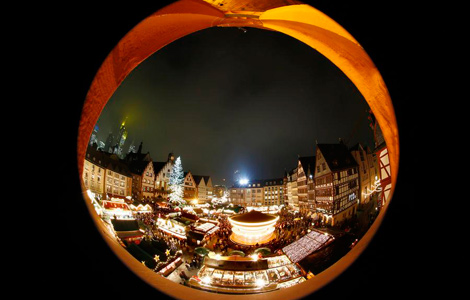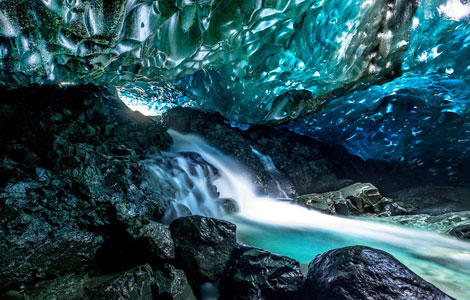Tidbits of panda
Updated: 2013-11-28 14:25
(chinadaily.com.cn)
|
|||||||||||
The practice of Panda Diplomacy dates back more than 1,000 years ago. It existed as far back as the Tang Dynasty. During the reign of Empress Wu Zetian (625-705), she sent a pair of pandas to the Japanese emperor in 658 AD. The Japanese Imperial yearbook also made similar records.
On Sep 18, 658 AD (Chinese lunar calendar), two spacious tall cages draped with red flowers were surrounded by imperial guards and animal trainers. They rode on the post road express, starting from Chang'an the capital, and sped eastward. When they arrived at the Chinese portYangzhou, they boarded on the ship, along with the Japanese students toJapan. At that time panda was called white bear.
Pandas in the wild still preserve their ancestral habits of living alone. 6 month after birth, they leaving their mother and become a "loner" all day in the bamboo forest, so people call them "Bamboo hermit". Pandas do not have fixed place to live, they go anywhere they feel like in the bamboo forests, eating day and night, and they sleep at random places. When they are done eating, they go to sleep, and when they wake up, they start to eat again. They play everywhere, they are quite the jolly souls.
Pandas are very picky at their choice of beverage. Bison, goats, deer love to drink slightly salted water, panda hate it. If the water is a bit dirty or smells, they will even sniff at it. They only drink clean and sweet gurgling water, and they won't drink any backwater. Even in the winter, they don't go the easy way quenching their thirst by breaking the ice nearby. They will go lengthy to find the flowing river or any unfrozen fountain.
Pandas have been long leading the dimly lit jungle life, their vision is not very good, but long-loitering will not get them lost. Each panda has its own "territory", which is their "independent kingdom" and pandas' "wandering" is generally limited to the scope of its own territory.
After occupying the site, the panda will leave claw marks on trees, urine or poop leaving the smell. They don't forget to leave such marks when wandering out, so they will never get lost. In addition, at the base of the panda tail, there is a bare hairless area, hidden inside perianal glands that release sour substances and smell. Such smell can pass information between them and also the courting signal when coming across their loved ones.
During the winter, to escape chilling weather and famine, many animals go into hibernation. However, pandas still walk through the snow-pressed thick bamboos, like living in a white tent. They are not at all afraid of winter. The answer is in their "clothes". Its hair is coarse, which is full of medulla, each working like a thermos; its fur is layered and thick, which reinforces insulation. The greasy surface will refrain water and vapor from an easy entry into the skin. This thick "coat" enables the giant panda to resist cold and block moisture invasion, they won't suffer from rheumatism, nor they will ever go dormant, they even enjoy sleep in the snow.
Due to the low nutrition and low digestibility of bamboo, pandas have to keep on eating. An adult giant panda approximately consume 12.5 kilograms of bamboo a day, and their eating often lasts more than 13 hours. Correspondingly the number of times they excrete is also very impressive, a panda on average discharges more than 100 feces balls a day.
Pandas were originally carnivorous animals just like their cousin bear. It is hard for a predator to change from meat eating to feeding on vegetables. However, the giant panda is the only opposite case, and they chose the most difficult thing to digest. High-fiber bamboo is difficult to digest.
New research shows that panda genome is insensitive to the flavor of fresh meat, resulting panda not feeling the love for meat any more. Of course, another reason is that panda living environment has been constantly on the change.
Scientists have discovered in panda's gastric juice samples the existence of a large number of ciliates. Experts say that the ciliate may be effective in help the panda digest bamboo.
Docile and cute, pandas are not predator, but they catch bamboo rats, because they are a threat to panda's staple food bamboo. In order to catch them, pandas show no mercy. Although pandas look clumsy, they are particularly sensitive to any smell. They first smell out bamboo rats' hiding cave, and then firmly blow wind into the cave. Their two front paws at the same time slap the mud surface of the cave. The rats cannot afford the big noise and flee right into panda's hands.
When the rats are caught, panda will play the cat and mouse game. First they play with the rat in their palm or using the other palm to caress the rat. It often scares the rat into fake death, and panda will go away at certain distance. When the rat sneaks out under radar, panda p will quickly come back and capture the rat again. The game will repeat three or five times until the panda gets bored, and then the panda will EAT THE RAT ALIVE FOR GOOD!!!
When pandas drink, they behave like a toddler. They drink a few mouthfuls and leave, walk a few steps and return to the river to drink water again – Back and forth non-stop; but they are also massive drinkers like a drunkard. They drink happily, drink to the belly bulging into a ball, but even so they do not want to leave, often they drink the "hell" out of the water.
Male pandas pee with his body standing upside down and their rear end high up leaning on the tree. This "gymnastics stunt" can help panda's urine reach a higher tree location, thus enabling them to spread their odor, thereby increasing the success rate of their brief mating period.
Panda often takes the trouble to find the thickest trunks possible, ideally long rough bark, which helps the urine penetrate deeper into the trunk, so that the smell can remain longer. And scientists have found that their urine concentration is higher than any other kind of bears.
Related Stories
Panda diplomacy likely to boost ties 2011-02-22 07:29
Newborn pandas growing in Chengdu 2013-11-28 11:44
Thailand may seek another panda from China 2013-11-14 13:42
Twin panda cubs at Zoo Atlanta 2013-11-13 17:11
China releases captive-bred panda to the wild 2013-11-07 16:01
Female panda released into the wild 2013-11-07 00:06
Today's Top News
Chinese premier carries hectic schedule
EU, China set timetable for talks
Italy Senate expels Berlusconi
Sino-Russian border city to offer visa-free stays
China calm in face of US overflight
China to be largest oil importer
Clean energy fueling the future
China, Romania call their ties 'exemplary'
Hot Topics
Lunar probe , China growth forecasts, Emission rules get tougher, China seen through 'colored lens', International board,
Editor's Picks

|

|

|

|

|

|





